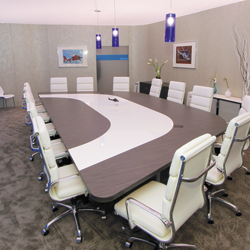Fabric basics
 What types of fabrics are typically used for exhibitry, and what's the least I need to know about fire-code issues with these materials? What types of fabrics are typically used for exhibitry, and what's the least I need to know about fire-code issues with these materials?

Fabric isn't only lightweight - a factor that can help cut weight-based drayage and shipping fees - it's also incredibly versatile,
allowing you to create everything from draped ceiling canopies to freestanding curved forms. Plus, given recent innovations in digital-printing technology and equipment, graphics
suppliers can offer high-quality, wide-format fabric graphics (whose widths can create mural-like panels and reduce the number of seams), and they can print with fade-resistant inks in a full spectrum of colors. So it's no wonder that exhibitors are flocking
to fabric components faster than "Project Runway" designers bolt through Mood Fabrics.
But before you stitch together a purchasing contract with a fabric-exhibit supplier, you need a rundown of the basic categories of fabric available as well as a short primer on construction types and fire-retardancy issues. Keep in mind, however, that each fabric-related industry - from exhibits to fashion to furniture - has its own fabric classifications, and each supplier uses company-specific terms as well. But Moss Inc., one of the industry's first fabric-exhibit firms, organizes its fabric line into the following material categories and construction types. While terms vary by supplier, this information will give you a broad understanding of what's available - allowing you to have an intelligent fabric-selection conversation with your suppliers and ultimately, to choose the fabric that's right for you.
Fabric Construction and Types
There are two main fabric-construction methods: woven and knit. Woven fabrics are created by yarn interlacings that form a 90-degree angle. These fabrics provide little stretch, so they offer good dimensional stability. Familiar examples of woven fabrics are denim, sheets, and umbrella fabric. Knit materials are created by looped-yarn interlacings. Knit fabrics stretch in one or both directions (top to bottom and/or side to side), so they're often used in tensioned-fabric components. Familiar examples of knitted fabrics are sweaters, socks, and pantyhose. So while Moss uses the following six terms to categorize its exhibit materials, all fabrics (except for nonwovens, like dryer sheets or baby wipes) can also be categorized as "woven" or "knit."
 Solids - This fairly broad category
of fabric includes nontransparent knit and woven fabric constructions. Solid fabrics are typically the most durable and cost effective of the available options. Solids with some stretch are ideal for covering structures and extrusions, and those without stretch are best for banner-style applications. Solids - This fairly broad category
of fabric includes nontransparent knit and woven fabric constructions. Solid fabrics are typically the most durable and cost effective of the available options. Solids with some stretch are ideal for covering structures and extrusions, and those without stretch are best for banner-style applications.
White solid fabrics are commonly used as a substrate for printed graphics, yet many fabric vendors also offer pre-dyed colors of solid fabrics for this purpose. These materials usually have good opacity (i.e., they don't let light pass through them). But to ensure complete nontransparency - particularly in instances when light passing through the fabric could dilute or distort a graphics image or text - some solids may require a liner. Also, some specially engineered solids can diffuse light, making them ideal for fabric light boxes or illuminated shapes, where light is placed behind the fabric.
 Mesh/Sheer - Mesh and sheer fabrics comprise a collection of transparent knit and woven materials. They are perfect for creating a light and airy feeling, as the eye travels through the material and beyond, creating the illusion of an open space. Mesh/Sheer - Mesh and sheer fabrics comprise a collection of transparent knit and woven materials. They are perfect for creating a light and airy feeling, as the eye travels through the material and beyond, creating the illusion of an open space.
Options from delicate to durable are available, and mesh/sheer fabrics work well with front and up lighting. White fabrics can be printed with graphics, and some materials are also available in colors. Since many fire-marshal codes stipulate that exhibit fabrics used for ceiling canopies must allow water from overhead sprinklers to pass through to areas below, mesh fabrics (which allow water to seep through) are extremely popular for such applications.
 Outdoor Fabrics - Outdoor fabrics are typically woven constructions with water-resistant coatings, which have the tightest yarn interlacings. Woven fabrics are also more stable, as they have less stretch and will hold their shapes in windy conditions. Outdoor fabrics are available in solid colors. Outdoor Fabrics - Outdoor fabrics are typically woven constructions with water-resistant coatings, which have the tightest yarn interlacings. Woven fabrics are also more stable, as they have less stretch and will hold their shapes in windy conditions. Outdoor fabrics are available in solid colors.
 Projection-Suitable Materials - While it's possible to project an image
onto any fabric or other type of surface,
projection fabrics (which are actually
a category of film materials) are engineered to broadcast images with ideal color, brightness, and clarity. While these materials are quite expensive and delicate, with special handling and careful patterning it is possible to use these materials in various structure and extrusion applications. Projection-Suitable Materials - While it's possible to project an image
onto any fabric or other type of surface,
projection fabrics (which are actually
a category of film materials) are engineered to broadcast images with ideal color, brightness, and clarity. While these materials are quite expensive and delicate, with special handling and careful patterning it is possible to use these materials in various structure and extrusion applications.
 Novelty - "Novelty" is a catch-all term for fabrics with special textures or finishing techniques. Novelties can be knits or wovens, sheer or solid. Examples of novelty fabrics include metallics, velvets, specialty vinyls, faux fur, and leather. Special handling, such as rolling instead of folding, may be required when using these fabrics. Novelty - "Novelty" is a catch-all term for fabrics with special textures or finishing techniques. Novelties can be knits or wovens, sheer or solid. Examples of novelty fabrics include metallics, velvets, specialty vinyls, faux fur, and leather. Special handling, such as rolling instead of folding, may be required when using these fabrics.
 Liners - A liner is a fabric used as a second layer behind the main or "viewing" fabric. Liners are woven materials with a coating to help block out light. (Think of a drapery liner that blocks light from coming in your window.) Trade shows and events often have an abundance of ambient light (if not from your exhibit, then perhaps from the one next to it), so sometimes a liner is required to fully hide internal framework. Special acoustic liners can also be used to assist other fabrics in blocking or absorbing sound. Liners - A liner is a fabric used as a second layer behind the main or "viewing" fabric. Liners are woven materials with a coating to help block out light. (Think of a drapery liner that blocks light from coming in your window.) Trade shows and events often have an abundance of ambient light (if not from your exhibit, then perhaps from the one next to it), so sometimes a liner is required to fully hide internal framework. Special acoustic liners can also be used to assist other fabrics in blocking or absorbing sound.
Burning Issues
Fire and flame retardancy are major
concerns for all types of exhibit fabrics, particularly since fabric structures must adhere to fire-related codes that can vary by country, state, city, and venue. Prior to purchasing a fabric component, discuss the fabric's fire ratings with your suppliers to ensure it will meet all codes by which your exhibit will be governed. Fabrics that are not inherently flame retardant (IFR rated) can also be treated with flame-retardant chemicals. And of course, always bring a copy of your fabric's Flame Retardancy Certificate
to each show you attend in case management or code-enforcement personnel ask to see it.
Fire codes also tend to be very specific about the type of materials that can be used as ceiling canopies as noted above. Along with mesh fabrics, Smoke-Out, a fabric that essentially dissolves in high heat, is often used for overhead canopies. However, both of these options come in a limited choice of colors, and Smoke-Out costs roughly four times as much as more common forms of solid fabric. Bottom line, always verify the fire-related specifications of each of your fabrics along with each show's requirements before finalizing your fabric-component purchase.
Given the lightweight, flexible, and aesthetically pleasing attributes of fabric components, they're tailor-made for the demands of the trade show world. Armed with this bare-bones knowledge of fabric types and fire-retardancy issues, you can start talking shop with the fabric supplier of your choice and implement some new fabric components into your exhibit-marketing strategy.
- Elissa Decker, fabric product
manager, research and development, Moss Inc., Elk Grove Village, IL
|






 What types of fabrics are typically used for exhibitry, and what's the least I need to know about fire-code issues with these materials?
What types of fabrics are typically used for exhibitry, and what's the least I need to know about fire-code issues with these materials? 



